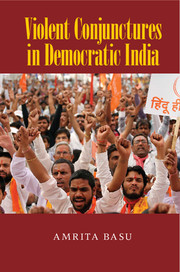Book contents
- Frontmatter
- Dedication
- Contents
- List of Figures and Tables
- Acknowledgments
- Glossary of Indian Words and Terms
- Indian Organizations, Institutions, and Political Parties
- Abbreviations of Political Parties and Organizations
- Introduction
- PART I THE PILLARS OF HINDU NATIONALISM
- PART II EXTENSIVE VIOLENCE
- PART III EPISODIC VIOLENCE
- 6 Uttar Pradesh: Movements and Countermovements
- 7 Himachal Pradesh: The Party Rules
- 8 Rajasthan: Two Phases of Party-Movement Relations
- 9 Conclusion
- Selected Bibliography
- Index
- Books in the Series (continued from page iii)
6 - Uttar Pradesh: Movements and Countermovements
from PART III - EPISODIC VIOLENCE
Published online by Cambridge University Press: 05 July 2015
- Frontmatter
- Dedication
- Contents
- List of Figures and Tables
- Acknowledgments
- Glossary of Indian Words and Terms
- Indian Organizations, Institutions, and Political Parties
- Abbreviations of Political Parties and Organizations
- Introduction
- PART I THE PILLARS OF HINDU NATIONALISM
- PART II EXTENSIVE VIOLENCE
- PART III EPISODIC VIOLENCE
- 6 Uttar Pradesh: Movements and Countermovements
- 7 Himachal Pradesh: The Party Rules
- 8 Rajasthan: Two Phases of Party-Movement Relations
- 9 Conclusion
- Selected Bibliography
- Index
- Books in the Series (continued from page iii)
Summary
Dalit leader Kanshi Ram famously commented, “The road to Delhi passes through UP (Uttar Pradesh).” UP is of enormous importance to Indian politics. It commands 80 out of 547 seats in the lower house of Parliament and 31 out of 245 seats in the upper house of Parliament. Many prominent nationalist leaders and seven of India's fourteen prime ministers have been elected from UP. With a population of 200 million people, UP would be the fifth largest country in the world. Not surprisingly, political scientists have studied UP extensively.
This chapter explores why Hindu nationalist militancy and violence in UP have been intermittent, and more specifically, why they peaked in the early 1990s, declined, and have since periodically reemerged. The Jan Sangh and BJP pursued moderate and militant strategies at different periods of time. I differentiate four major phases with particular attention to the least studied last two. In the first, starting in the late 1960s, the Jan Sangh formed coalitions with diverse political parties and movements that sought to unseat the Congress government. When it was unable to advance Hindu nationalist goals, it disrupted the coalitions it had formed. In the second phase, from the late 1980s until 1992, the BJP joined forces with a militant VHP-led movement and gained power independently. During the third phase (1993–2002), the BJP pursued a moderate strategy of coalition-building and increasing lower-caste representation within the party and its governments. Although many observers predicted that the days of militant Hindu nationalism were over, the BJP reverted to an activist role during the fourth phase, from 2002 on. Hindu nationalist militancy and violence were designed to overcome factionalism within the party and placate the RSS and radical activists.
This alternation between an aggressive, anti-minority posture and an inclusive, coalitional, moderate stance is puzzling. There was ample reason for the BJP to consistently pursue far-reaching Hindu nationalist goals. The RSS had strong support in UP among Hindu refugees from what became Pakistan. The Ayodhya dispute, which had reverberations in Gujarat in 2002, could well have continued to ignite Hindu-Muslim violence in UP. With the Congress Party's decline and the subsequent emergence of lower-caste parties, the BJP seemed the best representative of upper castes. However, the upper castes that deserted Congress to support the BJP in the wake of the Mandal-Mandir controversy did not remain loyal to the BJP.
- Type
- Chapter
- Information
- Violent Conjunctures in Democratic India , pp. 203 - 233Publisher: Cambridge University PressPrint publication year: 2015

